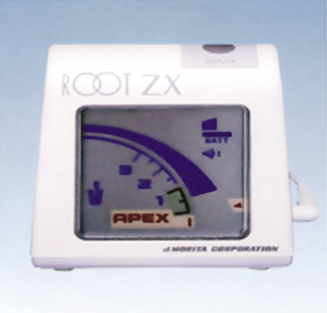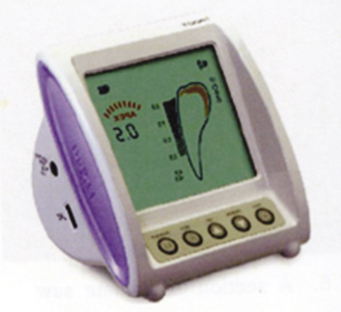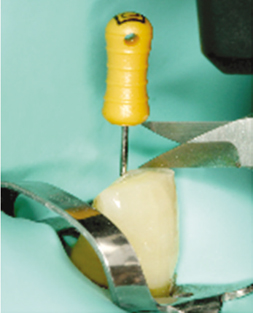J Korean Acad Conserv Dent.
2010 Nov;35(6):453-460. 10.5395/JKACD.2010.35.6.453.
In vivo evaluation of accuracy and consistency of two electronic apex locators
- Affiliations
-
- 1Department of Conservative Dentistry, Wonju Christian Hospital, Yonsei University, Wonju, Korea.
- 2Department of Conservative Dentistry, Yonsei University, Seoul, Korea. sjlee@yuhs.ac
- KMID: 2176467
- DOI: http://doi.org/10.5395/JKACD.2010.35.6.453
Abstract
OBJECTIVES
To evaluate the accuracy and consistency of two different apex locators at both the Apex and 0.5 marks.
MATERIALS AND METHODS
Twenty-six root canals was scheduled for extraction for periodontal or prosthodontic reasons. Thirteen canals were measured using Root ZX and the rest by i-ROOT. The root canal length was measured both the at 0.5 mark and the Apex mark. The file was then fixed to the tooth, and the distance from the file tip to the major foramen of each canal was measured after removing the root dentin under the microscope so that the major foramen and the file tip were seen.
RESULTS
1. When the Apex mark was used, 100% of both the Root ZX and i-ROOT groups were within 0.5 mm of the major foramen. 2. When 0.5 mark was used, 100% of the Root ZX group and 77% of the i-ROOT group were within 0.5 mm of the major foramen. 3. In terms of standard deviation and quartile value, the Apex mark was more consistent than 0.5 mark in the Root ZX group, and 0.5 mark was more consistent in the i-ROOT group, but there was no statistically significant difference when compared with t-test. 4. The root canal length difference between the Apex mark and 0.5 mark was 0.22 mm and 0.46 mm in the Root ZX and i-ROOT groups, respectively.
CONCLUSIONS
In this study, the Apex mark was the more consistent mark. Therefore, it is recommended to subtract 0.5 mm, which is the average length between the apex and apical constriction, from the root canal length at the Apex mark to obtain the working length clinically.
Keyword
Figure
Reference
-
1. Seltzer S, Soltanoff W, Sinai I, Goldenberg A, Bender IB. Biologic aspects of endodontics. 3. Periapical tissue reactions to root canal instrumentation. Oral Surg Oral Med Oral Pathol. 1968. 26(5):694–705.2. Seltzer S, Soltanoff W, Sinai I, Smith J. Biologic aspects of endodontics IV Periapical tissue reactions to root-filled teeth whose canals had been instrumented short of their apices. Oral Surg Oral Med Oral Pathol. 1969. 28(5):724–738.3. Kuttler Y. Microscopic investigation of root apexes. J Am Dent Assoc. 1955. 50(5):544–552.
Article4. Dummer PM, McGinn JH, Rees DG. The position and topography of the apical canal constriction and apical foramen. Int Endod J. 1984. 17(4):192–198.
Article5. Lee SJ, Nam KC, Kim YJ, Kim DW. Clinical accuracy of a new apex locator with an automatic compensation circuit. J Endod. 2002. 28(10):706–709.
Article6. Cluster L. Exact methods of locating the apical foramen. J Natl Dent Assoc. 1918. 5:815–819.
Article7. Suzuki K. Experimental study on iontophoresis. J Jpn Stomatol. 1942. 16:411–417.8. Sunada I. New metod for measuring the length of the root canal. J Dent Res. 1962. 41(2):375–387.
Article9. Inoue N. An audiometric method for determining the length of the canals. J Can Dent Assoc. 1973. 39(9):630–636.10. Kim E, Lee S. Electronic apex locator. Dent Clin North Am. 2004. 48(1):35–54.
Article11. Yamashita Y. A study of a new electric root canal measuring device using relative values of frequency response: influences of the diameter of apical foramen, the size of electrode, and the concentration of sodium hypochlorite. Jpn J Conserv Dent. 1990. 33:547–549.12. Kobayashi C, Matoba K, Suda H, Sunada I. New practical model of the division method electronic root canal length measuring device. J Jpn Endodon Assoc. 1991. 12:143–148.13. Kobayashi C, Suda H. New electronic canal measuring device based on the ratio method. J Endod. 1994. 20(3):111–114.
Article14. Hwang GY, Roh BD, Kim ES, Lee SJ. In vitro evaluation of the consistency of two electronic apex locators. J Korean Acad Conserv Dent. 2008. 33(1):20–27.
Article15. Yoon BH, Kim ES, Jung IY, Lee SJ. vitro evaluation of the consistency of two electronic apex locators. 2009. Department of Dentistry, The graduate school, Yonsei University.16. Fouad AF, Rivera EM, Krell KV. Accuracy of the Endex with variations in canal irrigants and foramen size. J Endod. 1993. 19(2):63–67.
Article17. Wrbas KT, Ziegler AA, Altenburger MJ, Schirrmeister JF. In vivo comparison of working length determination with two electronic apex locators. Int Endod J. 2007. 40(2):133–138.
Article18. Vieyra JP, Acosta J, Mondaca JM. Comparison of working length determination with radiographs and two electronic apex locators. Int Endod J. 2010. 43(1):16–20.
Article19. Kim E, Marmo M, Lee C, Oh N, Kim I. An in vivo comparison of working length determination by only root-ZX apex locator versus combining root-ZX apex locator with radiographs using a new impression technique. Oral Surg Oral Med Oral Pathol Oral Radiol Endod. 2008. 105(4):e79–e83.
Article20. Dunlap CA, Remeikis NA, BeGole EA, Rauschenberger CR. An in vivo evaluation of an electronic apex locator that uses the ratio method in vital and necrotic canals. J Endod. 1998. 24(1):48–50.
Article21. Pagavino G, Pace R, Baccetti T. A SEM study of in vivo accuracy of the Root ZX electronic apex locator. J Endod. 1998. 24(6):438–441.
Article22. Venturi M, Breschi L. A comparison between two electronic apex locators: an ex vivo investigation. Int Endod J. 2007. 40(5):362–373.
Article23. Goldberg F, Marroqun BB, Frajlich S, Dreyer C. In vitro evaluation of the ability of three apex locators to determine the working length during retreatment. J Endod. 2005. 31(9):676–678.
Article
- Full Text Links
- Actions
-
Cited
- CITED
-
- Close
- Share
- Similar articles
-
- In vitro evaluation of accuracy and consistency of four different electronic apex locators
- Evaluating Accuracy according to the Evaluator and Equipment Using Electronic Apex Locators
- In vitro evaluation of the consistency of two electronic apex locators
- An accuracy of the several electronic apex locators on the mesial root canal of the mandibular molar
- In vitro comparison of measurement accuracy in pre-enlarged and enlarged canals with four apex locators






